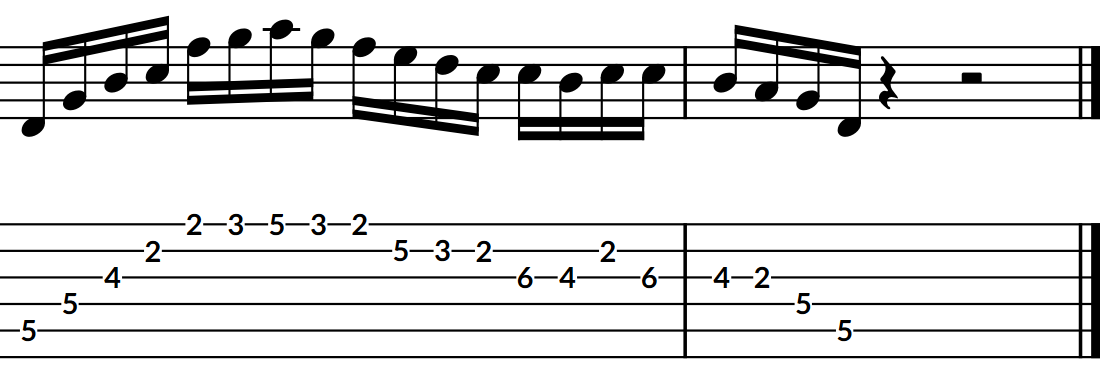When I first started playing guitar, I just wanted to be able to play songs, riffs and solos.
So I practiced songs, riffs and solos.
When I decided to go study music and guitar, I had to practice and study the fretboard and arpeggios and scales in order to improvise over jazz standards.
I wasn't that interested in playing standards though. I was (and still am) interested in the ability to improvise; what it takes to be able to improvise.
Nowadays my focus is to study and practice in order to remove bottlenecks.
Physical and mental bottlenecks.
In order for a clear stream to flow from my mind out of my instrument (ahem).
At least, that’s the ideal/goal.
I’ve always been searching for the most “efficient” way to study and practice, because there’s seemingly an endless amount to tackle.
A thing I realized over the years is that I was actually looking for fundamentals vs. superficialities.
Most of social media posts and “lessons” are superficialities. It’s just easier to sell and click on.
Fundamentals aren’t flashy, but… they’re foundational.
Look at this example:
I could make a tutorial showing how “cool” this sound is and that you could use it over this and that.
And then you’re going to go practice it, maybe put it through different keys… and eventually it’s not going to stick and you’re going to be frustrated and you’re going to hop onto the next thing.
(I’m judging by my own past experience and behaviour, so it’s no attack on anyone).
But let me backtrack, so you can see the steps that came before:
I started with the D major scale in one position
I was practicing stacking 4ths and sticking strictly within that position
I liked the very first shape (D-G-C#) and played it horizontally on one string set (2-4-5)
Then I added a note on the 3rd string
Then I added another 4th on top on the first string
Then I arpeggiated it
Then I incorporated the major scale at the top of the arpeggio figure
And then I added in the doubled unison on the 2nd and 3rd string
That’s 8 missing steps from where I started to where the “cool line” ended up.
8 steps you didn’t practice and go through.
If I only posted the cool line, I just gave you a superficiality; the opposite of fundamentals.
You don’t have to go through these exact steps, it’s not a formula or anything.
The point is just that you have to go through your own process of creating something. The only thing I would advice and add to that, is that you start from fundamentals.
Don’t start from superficialities.
Here’s something more elaborate that I ended up with during some “creative time”:
Practice Diary
I don’t know if this is interesting to anyone, but here’s a little “diary” I kept for what I practiced this past week:
21/04
D major 7 positions:
2nds, 3rds, ..., double 8ves (harmonically)
Stacked 4ths & 5ths
Triads
7th chords
3rd & 6th
3rd down, 2nd up
D major 3 NPS w/ position shift
SS 1-2
SS 2-3
SS 1-2-3
D major strict positions bottom to top w/ position shift
23/04
D major Double 4ths SS 2-4-5
Double 4ths w/added note SS 2-3-4-5
Idem SS 1-2-3-4-5
Creative time
24/04
Legato exercise 70bpm: 8ths, triplets, 16th, quintuplets - 3NS w/ doubled note
D major double 4ths in all positions
1st position Double 5ths + Double 6ths
Creative time
25/04
D major
7 positions all intervals, 70bpm quarter note (+/-40 min)
27/04
D major
2nds harmonic horizontal SS 2-3 1/4 note 80bpm
4ths melodic 16th notes 80bpm
5ths harmonic 1/4 note 80bpm
1-6-4-2-5-7-1-3-4-#4°-5-7-1 arpeggios 16th notes - 7 positions
William Leavitt - Reading studies for guitar p. 4-5 70bpm
As you can see, I just stayed in D major for the entire week. I worked through my positions, I worked through the different intervals from seconds all the way up to double octaves (which would be 15ths). I approached the same material from different angles, I shifted positions, I used specific tempi and rhythms, I created with it, etc.
How do you determine what’s fundamental and what’s superficial?
It basically comes down to drilling down to the origin of things. Kind of like asking “why” 5 times.
Fretboard knowledge is fundamental, positions, reading skills, harmonic knowledge, … That’s why I’m posting this stuff, to help cut through the noise and direct your attention to the things that will make everything easier downstream.
Here’s a little legend for the abbreviations, by the way:
SS = String Set
3 NPS = 3 Notes Per String
Creative Time = Create something with what you’ve practiced
Double 4ths, 5ths, 6ths = two 4ths (or 5ths or 6ths) stacked on top of each other, i.e. C-F-B or C-G-D or C-A-F
Harmonical means “noted are played simultaneously”
Melodic means ‘notes are played one after the other”
Until next time and happy practicing.










